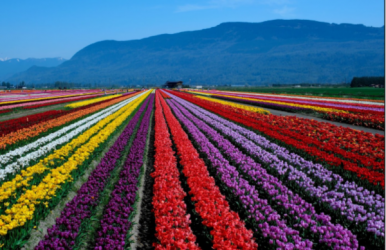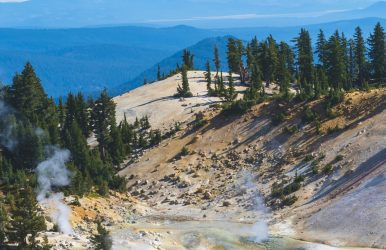The Ultimate Guide to Visiting the Skagit Valley Tulip Festival
BY Pijus Maity Mar 27, 2025
A few flowers can capture the overall essence of spring, and tulips are one of them. The vibrant colors, elegant shapes, and rich history make tulips the ultimate symbol of renewal and beauty. Even though the tulip mania significantly contributed to the 17th—17th-century Dutch economic bubble, the Skagit Valley Tulip Festival is the prime example that the mania is still alive. Imagine this: You are walking through an endless field filled with red, purple, yellow, and pink tulips! The fields stretch as far as your eyes can see! That’s the feel! This is a dream come true for photographers, a paradise for nature lovers, and a perfect place to breathe some fresh air. So, as you start your journey, you must read this guide to the 2025 Skagit Valley Tulip Festival. In this guide, we will talk about the best time to visit the Skagit Valley Tulip Festival, where you can find the tulip gardens and enjoy your trip as much as possible. Here’s The Guide To The Skagit Valley Tulip Festival The Skagit Valley Tulip Festival is the ultimate way to celebrate spring. Want to enjoy it to the fullest? Check out the following guide to experience the beauty of tulip gardens with friends and family. Pick the Right Time to Visit It is always necessary to choose the travel time, no matter where you go. Regardless of the dependency on the weather, the Skagit Valley Tulip Festival runs for the entire month of April. In the earlier month of April, you may catch a few daffodils. The tulips start to bloom somewhere between mid to late April. Thus, you must check the blooming status to avoid disappointment once you go there! This will help you plan your trip accordingly, especially when the colorful flowers are at their best! Also, I would suggest you visit the Skagit Valley Tulip Festival on the weekdays since the weekends are very busy and crowded. You should see the field early in the morning. This way, you will be able to experience a quieter and relaxed landscape. Dress for the Weather In the Pacific Northwest, spring weather can change quickly. One moment, it's warm and sunny; the next, it could turn cool and rainy. That's why I think wearing layers would be a smart move. This way, you can add or remove clothing based on the temperature shift. Next, you must think about your shoes. The fields often get muddy, especially if it rains. So, waterproof shoes or boots keep your feet dry and help you walk comfortably. In contrast, flip-flops and dress shoes make moving hard and can easily get ruined. Choose Your Tulip Farms The festival is spread across several tulip farms throughout the valley. Each farm has its charm. Thus, you must explore more than one because it gives you a fuller experience. Before you head out, check each farm's website for hours and ticket details. Some locations, especially on busy weekends, require advance tickets. Here’s a breakdown of the key farms and gardens Roozengaarde: This is famous for its 50-acre display with numerous tulips and a huge variety of tulips. Roozengaarde is the ultimate destination for spring lovers. Tulip town: This specifically features various tulips across 5 acres of fields. Tulip Valley Farms: The only U-pick tulip farm located in Skagit Valley. You can have a great time there with your friends and family. Garden Rosalyn: This 7-acre garden of tulips also includes ponds with ducks and geese, making it more attractive. Skagit Acres: A new addition to the Skagit Valley Tulip Festival in 2025. The field will include 3-acre tulip fields. Enjoy Local Food and Shops The nearby towns add even more to your visit. You can visit places like Mount Vernon, La Conner, and Burlington. These places are excellent places to dine in the Pacific Northwest. Moreover, you'll find local spots serving fresh meals, sweet treats, and unique finds. You'll also see food vendors set up near the Tulip Valley farm. You can visit there, between farm visits. So, you can grab a warm drink or a quick bite while you take a break! Some stands even offer tulip-themed gifts or fresh bouquets, which are probably great souvenirs to take home. Plan for Traffic and Parking The roads around Mount Vernon can be crowded during the Skagit Valley Tulip Festival, which happens more often on weekends and when the weather is nice. On top of that, many roads near the farms are narrow. So getting where you're going can take longer. I suggest you give yourself extra time to stay on track. Moreover, you might face poor network challenges. Before your trip, you can download maps and directions. Once you get there, you can try to look for signs or volunteers to guide you. Most farms have free parking, but a few might charge a small fee. Bring Your Camera, But Be Respectful The Tulip fields are perfect for photos. Whether you use your phone or a camera, you'll find many great spots to capture the view. When you are exploring, you must stay on the marked paths. If you step into the rows, you can damage the flowers and spoil the experience for others. It's also crucial to protect the work of the farmers. Treat the fields with care so everyone can enjoy their beauty. If you plan on using a drone, check the rules first. Most farms don't allow them, so it's better to know before you go. Bring Your Family The festival is a fun outing for all ages, making it one of the best places to travel with kids. Still, you might face a few challenges if you're bringing little ones, Strollers can be hard to push through muddy ground. A baby carrier often works better in the fields of tulips. You'll likely be outside for a while, so pack snacks, drinks, and a few wipes for comfort. Many farms also offer things for kids to enjoy, like play zones or tractor rides, which makes the experience even better for them. The Best Way To Plan Your Visit: Here’s How You Can Purchase The Tickets So, are you ready to experience the beauty of the Skagit Valley Tulip Festival from up close? In the following section, I will provide you with all the details about the tickets for the tulip gardens. Read on… RoozenGaarde The ticket price for RoozenGaarde from Monday to Thursday is $16. The same ticket price from Friday to Sunday is $20. Further, it remains open from 9 AM to 7 PM from Monday to Friday. The visiting hours on Saturday and Sunday are 9 AM to 7 PM. Tulip Valley Farms The ticket prices for entry to Tulip Valley Farms vary based on your age and the group you belong to. For example, the ticket price for children aged 3 to 15 is $10. For adults (16+), it is $16 from Monday to Thursday and $18 from Friday to Sunday. Again, for seniors and military persons (with IDs), the ticket price is $15 from Monday to Thursday and $17 from Friday to Sunday. Tulip Valley Farms opened on 1 April 2025 and will remain open until 30 April 2025. During the season, it is open from 9 AM to 5 PM, 7 days a week. Tulip Town The online ticket prices for visitors aged above 12 are $18. You can also make an in-person booking for $20. Further, Tulip Town will remain open from 1st to 30th April 2025, seven days a week during the spring season. The hours of operation are Monday through Thursday, 10 AM to 6 PM, and Friday through Sunday, 9 AM to 7 PM. Garden Rosalyn You can book the tickets for Garden Rosalyn in person and online at $17. It will remain open from 1st to 30th April 2025 on all days of the week. Skagit Acres Skagit Acres offers online and in-person booking facilities. The ticket prices for children aged 6 to 12 are $10, and for adults, they are $18. Seniors above 65 years and Military persons will get tickets at $15. Further, the garden center of Skagit Acres remains open year-round. However, the tulip field is only open from the 1st to the 30th of April. Booking tickets for the Skagit Valley Tulip Festival is pretty straightforward! Visit https://tulipfestival.org/garden-tickets/ and select the garden according to your preferences. The site also provides the location and directions for the garden. Ways to Reach the Skagit Valley Tulip Festival There are multiple ways to visit the Skagit Tulip Festival. However, walking is not recommended. By Bike The valley roads are pretty flat. So, travelling by bike can be much easier for you to access the tulip fields, events, and attractions. However, you must stay prepared for rainy and windy weather conditions. Before traveling, you can check out self-guided bike tours to learn the do’s and don’ts. By Car If you decide to drive a four-wheeler, then you must take state route 20 to enter the tulip area. You can find plenty of free parking at RoozenGaarde, Tulip Valley Farms, Garden Rosalyn, and Tulip Town. Roadside parking is pretty limited due to weather conditions and traffic safety. Law enforcement might issue a ticket for parking in the no-parking zone, so stay aware of it! By Bus Skagit Valley transient services have several routes across the valley. If you arrive in Mount Vernon, you can ride the Skagit Transit Route 615 to visit the tulip fields. All of the transports depart from the Skagit Valley Station. By Train Amtrak Cascades travels to Mount Vernon. However, there is no shuttle available from the station. You just have to make reservations, as the trains are small and fill up pretty quickly. Conclusion The Skagit Valley Tulip Festival is a springtime experience like no other. If you can make the right planning, the right gear, and a flexible mindset, you can enjoy a day surrounded by endless color and beauty. Whether you're snapping photos, walking hand-in-hand with a loved one, or watching your kids run through the vibrant tulips, the memories you make here will last long after the flowers fade. So grab your boots, charge your camera, and prepare for one of Washington's most beautiful tulip garden adventures!












